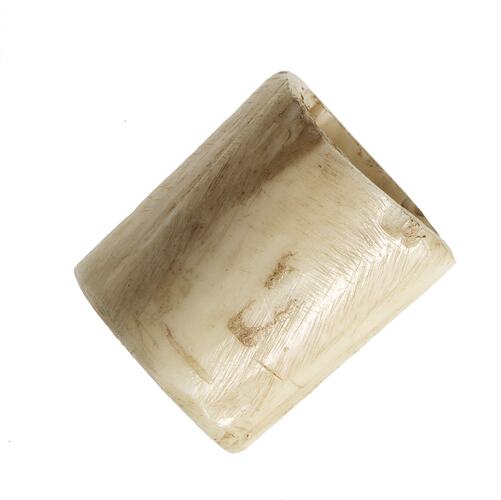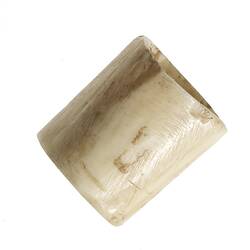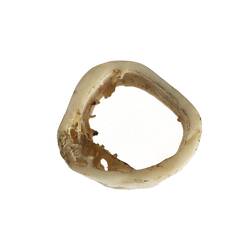Summary
A mili-mili-u is an ornament that was worn by the Wemba Wemba peoples through the pierced septum of the nose. A pin-kee (needle) made from the thighbone of the emu was used to pierce the nasal septum. A piece of reed was slipped on to the point of the pin-kee and left in place when the needle was withdrawn, acting as a cannula to dilate the opening.
The reed size was gradually increased until the opening was sufficiently large for the mili-mili-u (a piece of bone from the leg of an emu or kangaroo) to be inserted. The boys wore this nose ornament until their coming-of-age. Girls underwent the same procedure, but wore a kolko (ring of bone) from the wing of the Narroo-cee (bustard).
First Peoples men and women from a multitude of groups around Victoria and Australia wore nose pegs of bone, wood, quill, shell and reed stem for ceremonial and everyday ornamentation.
While other south-eastern Aboriginal peoples, such as the Wurundjeri, mainly used kangaroo bone for ornamentation of this type, the process differed slightly for First Peoples communities in the Western District. A short tube made from the large wing-bone of a swan was inserted to keep the hole open. The ring was rotated occasionally, while the nose was kept moist by holding the face over a vapour bath, produced by pouring water over hot stones.
Local Name
Mili-mili-u
Physical Description
Piece of bone (fashioned from the leg bone of a kangaroo or emu) worn in the septum of the nose.
Significance
The Wemba Wemba Nation straddles both sides of the Murray River and includes the large townships of Deniliquin, Moulamein and Swan Hill. Wemba Wemba country also includes the major tributaries of the Edward River and Wakool River.
On Monday February 5, 2016 Swan Hill Primary School Wemba Wemba Class students, together with the Victorian Aboriginal Corporation for Languages and the Victorian Aboriginal Education Association, launched a Wemba Wemba language resource in the form of an interactive digital app. This resource contains images and wordlist categories in the Wemba Wemba language which allows the Wemba Wemba community to learn the language and connect further with Wemba Wemba country. The app features language speakers Stephanie Charles and Fay Stewart. This resource is an excellent example of the use of new technologies to assist in language and cultural revivals being undertaken by many First Peoples communities.
More Information
-
Object/Medium
Ornament, nose
-
Maker
-
Locality
-
Date Produced
-
Object Measurements
20 mm (Length), 15 mm (Width), 15 mm (Height)
-
Classification
-
Date Made
-
Maker
-
Clan/Language Group
-
Place Made
-
Indigenous Region
-
Keywords
-
Type of item
-
Discipline
-
Category
-
Collecting Areas


